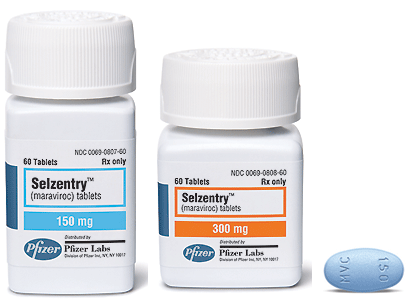Product
Selzentry
Approval Date
August 6, 2007
Release Date
September 25, 2007
Company
Pfizer
Class
Antiretroviral (CCR5 co-receptor antagonist)
Indication
HIV-1 infection in treatment-experienced adults infectedwith only CCR5-tropic HIV-1 detectable, who have evidence of viral replicationand HIV-1 strains resistant to multiple antiretrovirals.
Active Ingredient
Maraviroc 150mg, 300mg; tabs.
Agency Roster
Euro RSCG Life LM&P (professional)
MarketingStrategy/Execution
Pfizer’s Selzentryis designed to prevent HIV from entering uninfected cells by blocking the CCR5receptor. As the first in a new class of drugs targeting HIV-infected patients whohave CCR5-tropic virus (roughly half of all extensively treatment-experiencedpatients), the drug offers an alternative for those who have failed allother therapies. However, itsposition as an option of last resort could limit commercial potential. Selzentry sales of $500 million areprojected by 2011. Pfizer is submitting marketing applications around the worldand recently received a positive opinion from the CHMP in the EU, where the drugwould be sold as Celsentri. Analysts also expect Merck’s integrase inhibitorIsentress (raltegravir), approved after Selzentry for use intreatment-experienced patients, to provide stiff competition.
The Market
| Antiretrovirals US sales ($000s) last 5 years | |
| 2006 | $5,643,864 |
| 2005 | $5,195,036 |
| 2004 | $4,781,364 |
| 2003 | $4,013,637 |
| 2002 | $3,609,253 |
| Source: IMS Health, Oct. 2007 |
|
| Top 5 antiretrovirals | ||
| Jan.-July ’07 US sales ($000s) | % sales growth over Jan.-July ‘06 | |
| VALTREX (GlaxoSmithKline) | $774,202 | 22% |
| TRUVADA (Gilead Sciences) | $431,789 | 6% |
| ATRIPLA (Bristol-Myers Squibb/Gilead Sciences) | $420,599 | *** |
| REYATAZ (Bristol-Myers Squibb) | $331,420 | 19% |
| KALETRA (Abbott) | $285,411 | 5% |
| Source: IMS Health, Oct. 2007 |
||
Physician Outlook
Selzentry represents an important new addition to theexpanding HIV medication arsenal. It is the first CCR5 co-receptor antagonistand works by inhibiting viral entry at the cell surface. According to thelabel, Selzentry combined with an optimized group of other workingantiretroviral (ARV) agents, is more than twice as effective in CCR5-tropictreatment-experienced patients (vs. an optimized group of ARVs alone), isgenerally well-tolerated, and is dosed twice-daily. Prior to institutingSelzentry, physicians must utilize Monogram’s Trofile tropism assay to ensurethat the patient’s virus is CCR5- (vs. CXCR4- or R5/X4-) tropic.
—Noah Pines, executive VP, GfK V2, October 2007
Also in the Pipeline(according to Adis R&D Insight)
Drug: Macrolin
Manufacturer: Novartis
Indication: Acute myeloid leukaemia, HIV-1 infections,Non-Hodgkin’s lymphoma, Cancer
Active Ingredient: Aldesleukin
Phase: III (Acutemyeloid leukaemia, HIV-1 infections, Non-Hodgkin’s lymphoma), II (Cancer)
Drug: R165335/TMC125
Manufacturer: Tibotec BVBA
Indication:HIV infections treatment
Active Ingredient: Etravirine
Phase: Filed
Drug: Pegasys
Manufacturer: Roche
Active Ingredient: Peginterferon alfa-2a
Indication: Neurofibromatosis, Cancer metastases, Renalcancer, HIV infections treatment
Phase: I (Neurofibromatosis), II (Cancer metastases, Renalcancer), III (HIV infections treatment)
Drug: Leukine/ Prokine
Manufacturer: Amgen,Bayer HealthCare Pharmaceuticals
Indication: HIV infections treatment, Malignant melanoma,Mycoses, Non-Hodgkin’s lymphoma, Prostate cancer, Pulmonary alveolarproteinosis, Varicose ulcer, Multiple sclerosis, Mycobacterium avium complexinfections, Neonatal infections, Vaccineadjuvant
Active Ingredient: Sargramostim
Phase: III (HIV infections treatment, Malignant melanoma,Mycoses), II (Non-Hodgkin’s lymphoma, Prostate cancer, Pulmonary alveolarproteinosis, Varicose ulcer), I (Multiple sclerosis), Clinical (Mycobacteriumavium complex infections, Neonatal infections, Vaccine adjuvant)
Drug: SCH 417690
Manufacturer: Schering-Plough
Indication: HIV-1 infections
Active Ingredient: Vicriviroc
Phase: III
Source: Wolters Kluwer Health, Oct. 2007
Recent MM&MCoverage
FDApanel backs speedy approval for Merck HIV Drug
FDAapproves Pfizer’s maraviroc HIV treatment
Pharmacology
Maraviroc blocks the interaction between HIV-1 gp120 and thechemokine receptor on the T-cell membrane known as CCR5. By blocking thisinteraction, the drug prevents the virus from entering T-cells. It is effectiveonly against those strains of HIV-1 that are CCR5-tropic. The infection ofimmune cells by dual-tropic and CXCR4-tropic strains of HIV-1 is not inhibitedby maraviroc. Therefore, tropism testing should be done and treatment historyshould be taken into account to evaluate the appropriateness of this drug.Virologic failure may occur in patients with resistance to maraviroc or withthe outgrowth of undetected CXCR4-tropic virus that may have been presentbefore treatment.
Clinical Trials
Two ongoing trials are being conducted with maraviroc inpatients with CCR5-tropic HIV-1 infection. At study entry, patients had a viralload of >5,000 copies/mL despite at least 6 months’ therapy with at leastone agent from 3 out of the 4 classes of anti-retrovirals, or documentedresistance or intolerance to at least one member of each drug class. They wereplaced on an optimized background regimen with 3–6 antiretrovirals, thenrandomized to either maraviroc 300mg once daily, maraviroc 300mg twice daily,or placebo. Doses were adjusted based on background therapy. After 24 weeks,61% of maraviroc patients had a viral load of <400copies/mL, compared to 28%of those given placebo. Increases in T-cell counts were higher in the maravirocpatients than in those given placebo.
In a study in patients infected with dual/mixed co-receptor tropicHIV-1, maraviroc was not associated with a significant decrease in viral load.
Adverse Reactions
Cough, pyrexia, upper respiratory infections, rash,musculoskeletal symptoms, abdominal pain, dizziness; hepatotoxicity (may bepreceded by systemic allergic reaction; immediately evaluate if occurs); others(see literature).
Adults
Swallow whole. =16 yrs: Concomitant CYP3A inhibitors (eg,PIs except tipranavir/ritonavir, delavirdine, ketoconazole, itraconazole,clarithromycin, nefazodone, telithromycin) (with or without a CYP3A inducer):150mg twice daily. Other concomitant drugs, including tipranavir/ritonavir,nevirapine, NRTIs, enfuvirtide: 300mg twice daily. Concomitant CYP3A inducers(eg, efavirenz, rifampin, carbamazepine, phenobarbital, phenytoin) (without astrong CYP3A inhibitor): 600mg twice daily. Renal dysfunction(CrCl<50mL/min) and CYP3A inhibitors: monitor closely for side effects (eg,dizziness).
Children
<16yrs: not recommended.
Contraindications
Precautions
Liver dysfunction or disease. Re-evaluate if hepatitis orelevated LFTs develop. Cardiovascular risk factors. Postural hypotension.Monitor for immune reconstitution syndrome, infections, malignancies. Pregnancy(Cat. B). Nursing mothers: not recommended.
Interactions
Concomitant St. John’s wort: not recommended. May affect, or beaffected by, CYP3A inhibitors or inducers and drugs affected by p-glycoprotein(eg, potentiated by ketoconazole, lopinavir/ritonavir, ritonavir, saquinavir,atazanavir; antagonized by rifampin, efavirenz). Caution withantihypertensives.









